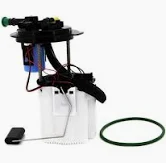The process for diagnosing an electric fuel pump involves taking a look at the most often seen reasons electrical problems, fuel supply issues and age form significant factors of failure. Step 1, FUEL TEST: One of the first things to check is fuel pressure using a basic Fuel Pressure Gauge. Newer vehicles will typically range anywhere from 35 to 65 PSI, depending on your recommended specs. Attach the gauge to the Schrader valve on the fuel rail and turn ignition to "ON" position without starting engine. If the pressure reading is below manufacturer specced pressures, this could mean that your pump isn't delivering adequately enough fuel; which would be a huge problem.
Hear for the sound of operating pump. Upon initial turning of the key in the ignition, you will want to listen for a low hum or whine from electric fuel pump (this is it running). If still no sound, the pump may be broken or it could also involve an electrical error like a blown fuse, or faulty relay. In about 30% of fuel pump failures, the cause is electrical issues. You can also check the fuse box for a blown, or otherwise buggered up fuel pump relay by pulling one of similar amperage and putting it in place to see if this fixes your issue.
Then you can confirm voltage to the pump. Check voltage at pump electrical connector with a multimeter When the ignition is switched on, there should be 12-14 volts at pump[]. If the voltage is lower than this can suggest issues with wiring or a bad connection. These wires may be corroded or damaged and it will prevent the pump from receiving enough power to function, so check your wiring for signs of wear or corrosion – this is a very important aspect.

Fuel pump problems can also arise from clogged fuel filters, which limit the flow of gas to your engine and can mimic symptoms like those that indicate a bad pump. Chances are, if it has been more than 20-30k between a fuel filter change and your car is having problems picking up speed - changing the filter could solve your problem. With a clogged filter, the pump has to work harder and this can cause premature wear or eventual failure of your pump over time.
A bad fuel pressure regulator might also be the culprit in some cases. The regulator maintains pressure in the fuel system and regulates how much fuel the pump can deliver. When the regulator goes bad, this can cause an irregular fuel pressure which makes it seem as though you have a faulty pump when in reality its your FPR. Some performance issues can be alleviated by simply testing or replacing the regulator and without the necessity of a new pump.
If all the checks carry out properly then most likely it might be a time to replace your fuel pump. An electric fuel pump would usually live for 100,000 to about a lack and fifty thousand miles but could also die out if such habbits as running the car on low gas or even bad fuil being brought into contact with an ensuing explosion. At this point, the pump has either failed completely or is no longer able to provide good fuel pressure and must be replaced.
Choose from among this list to find trusted Electric Fuel Pump options and additional troubleshooting tips or visit Electric Fuel Pump for product-specific solutions engineered for your vehicle.
